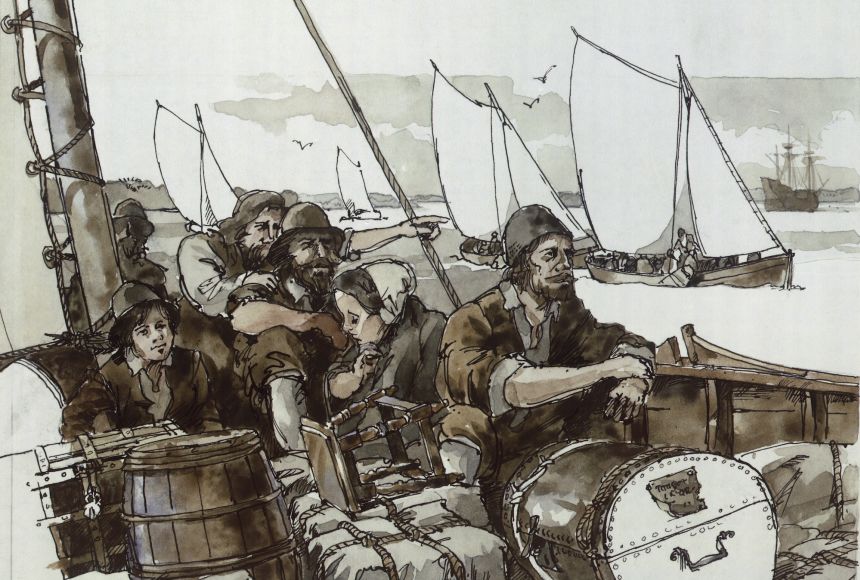Hundreds of years ago, Europe went through a period of exploration and colonization. Europeans had grown used to receiving goods from Asia such as silk, spices, and pottery. For centuries these goods had traveled the Silk Road, a trade route that connected the East and the West.
However, in the 16th century, the Ottoman Turks began to take over the Mongol Empire and new leaders were put in place. At the same time, shipbuilding and sea navigation became more advanced. European countries began traveling farther and for longer periods by sea.
Christopher Columbus was among the first to seek a faster, more direct route to Asia. Contracted by Queen Isabella and King Ferdinand of Spain, the Italian explorer began sailing west rather than east. In 1492, Columbus landed on an island he believed to be in East Asia; however, it was an island in the Caribbean. Columbus, along with another Italian explorer, Amerigo Vespucci, called this the "New World." At the time, the most powerful European countries were Spain, France, the Netherlands, and England, and each country sent explorers to colonize the lands, creating permanent settlements.
These European superpowers fought each other to control the New World. While each desired the wealth and power of colonization, every country had a different motivation and method of colonization.
God, Gold and Glory
Spain was driven by three main motivations. The first two were fame and fortune. The Spanish were famed for their success in conquering lands, especially in South America, where they conquered the Aztec and Inca Empires. Even today, a fort built in 1565 by the Spanish still stands in St. Augustine, Florida. It is the oldest European settlement still standing in the United States. Although most other settlements were destroyed after clashes with indigenous people, the country grew rich from the wealth they took from gold and silver in Central and South America.
Spain also fought to spread Christianity through what were called missions. The main goal of these missions was to convert indigenous people to Christianity, as well as to teach them European ways. In 1598, the first mission was led in New Mexico by Don Juan Oñante, who explored the southwest in search of gold. Throughout the ages, missions would take place anywhere the Spanish had influence, such as present-day Florida, Texas, New Mexico, and Arizona. In 1769, Father Junipero Serra built Mission San Diego. This was the first mission in present-day California and, like others, had soldiers protecting the settlement.
Over time, these missions grew from villages to cities. The areas of land grew, as farms expanded and many explorers used the missions as a home base to return to. Some of today's largest cities in the southwestern United States were once missions.
Fur Fervor
France focused its attention on a demand that seemed to be never-ending. Animal furs could be traded for French goods from the Native Americans. In 1534, navigator Jacques Cartier claimed northern North America for France. In 1608, the explorer Samuel de Champlain created the first French settlement in Quebec, Canada. However, France's colonial population was always relatively small.
The Netherlands had a very powerful navy despite its small size, which allowed it to prosper. The Dutch created colonies by controlling trade with the Spice Islands, which are now part of Indonesia. In 1609, the Dutch employed the English explorer Henry Hudson. His duty was to find a water route to reach Indonesia more quickly. While he did not find such a passage, he did discover what is now known as the Hudson River, which flows between today's New Jersey and New York.
Along this river, the Dutch established settlements that they called New Netherland. The island of Manhattan was purchased from indigenous people in 1626 and renamed New Amsterdam after their capital city. While the Dutch had formed an established foundation, their success was short-lived. In 1664, the British took over the colony and renamed it New York.
England Establishes Permanent Colonies
Of all the European countries, England was the most successful in North America. In 1606, King James I colonized Virginia through a company made up of individuals who pooled money for colonization. Like other countries, England was motivated by the riches as well as its easy access by sea. They settled the colony of Jamestown. However, Britain soon built permanent settlements in the New World for a different reason.
Religion was a key motivation of British colonization. In 1620, a group of settlers left England in pursuit of the New World. Among them were separatists, who believed the Church of England to be dishonorable, and thus tried to break away from it. They believed that in the New World they might have the opportunity to freely live by their own faith. Although they were attempting to get to Jamestown, Virginia, their ship was blown off course. They landed on the coast of what is now Massachusetts and named their settlement Plymouth, after the town from which they originally set sail.
These were the first Pilgrims, and they were followed by many others. The colonies in New England cultivated many materials, engaging in fishing, lumber, and shipbuilding. Farther south, colonies produced tobacco, rice, and indigo. All of this greatly benefited Britain—at least until the colonies fought for and won their independence almost 200 years later.

